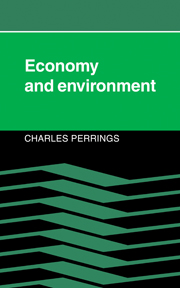 Economy and Environment
Economy and Environment Book contents
- Frontmatter
- Contents
- Preface
- Notation Guide
- 1 Introduction
- Part I The physical economy-environment system
- 2 Closed physical systems: a model
- 3 Structure and time in the physical system
- 4 Technological change and the environmental constraints to physical growth
- Part II The economic system
- Part III Environmental strategies in an evolutionary economy-environment system
- References
- Index
3 - Structure and time in the physical system
Published online by Cambridge University Press: 20 March 2010
- Frontmatter
- Contents
- Preface
- Notation Guide
- 1 Introduction
- Part I The physical economy-environment system
- 2 Closed physical systems: a model
- 3 Structure and time in the physical system
- 4 Technological change and the environmental constraints to physical growth
- Part II The economic system
- Part III Environmental strategies in an evolutionary economy-environment system
- References
- Index
Summary
The significance of system structure
We have seen that technological change results wherever residuals are generated in the processes of system production subject to the conservation of mass. On the other hand, we know that particular economic systems – and some ecological systems – have changed comparatively little over extended periods. The imperative to change is obviously much weaker at the micro than the macro level. Why? I now consider the implications of system structure both for the pressures to change in technologically stationary or time-invariant subsystems and for the legitimacy of the classical free disposal and free gifts assumptions.
By assumption 2 the global physical system is indecomposable over its history, implying that it cannot be broken down into historically disjoint subsystems. It is not possible to identify any set of processes that is entirely independent of all other past or present processes. Yet we do commonly assume that it is legitimate to treat particular sets of activities “as if” they were independent. The concept of “final” demand in multisectoral planning models of the Leontief type, for example, supposes that the consumption activities generating such final demands have no feedback effects on the conditions of production of consumer goods. Although the indecomposability assumption asserts that such suppositions are illusory, this chapter considers the conditions in which subsystems of an indecomposable general system may be thought to approximate decomposable systems.
- Type
- Chapter
- Information
- Economy and EnvironmentA Theoretical Essay on the Interdependence of Economic and Environmental Systems, pp. 31 - 46Publisher: Cambridge University PressPrint publication year: 1987


